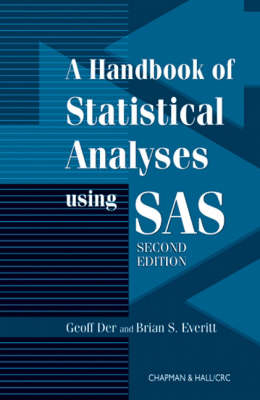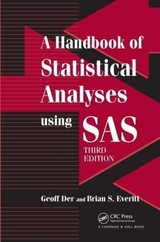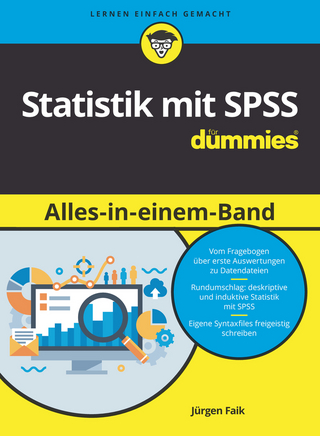
Handbook of Statistical Analyses Using SAS, Second Edition
Chapman & Hall/CRC (Verlag)
978-1-58488-245-9 (ISBN)
- Titel erscheint in neuer Auflage
- Artikel merken
Powerful software often comes, unfortunately, with an overwhelming amount of documentation. As a leading statistics software package, SAS is no exception. Its manuals comprise well over 10,000 pages and can intimidate, or at least bewilder, all but the most experienced users.
A Handbook of Statistical Analyses using SAS, Second Edition comes to the rescue. Fully revised to reflect SAS Version 8.1, it gives a concise, straightforward description of how to conduct a range of statistical analyses. The authors have updated and expanded every chapter in this new edition, and have incorporated a significant amount of new material. The book now contains more graphical material, more and better data sets within each chapter, more exercises, and more statistical background for each method. Completely new topics include the following:
Data description and simple inference for categorical variables
Generalized linear models
Longitudinal data: Two new chapters discuss simple approaches, graphs, summary measure, and random effect models
Researcher or student, new user or veteran, you will welcome this self-contained guide to the latest version of SAS. With its clear examples and numerous exercises, A Handbook of Statistical Analyses using SAS, Second Edition is not only a valuable reference, but also forms the basis for introductory courses on either SAS or applied statistics at any level, from undergraduate to professional.
A BRIEF INTRODUCTION TO SAS
Introduction
The Microsoft Windows User Interface
The Editor Window
The Log and Output Windows
Other Menus
The SAS Language
All SAS Statements Must End with a Semicolon
Program Steps
Variable Names and Data Set Names
Variable Lists
The Data Step
Creating SAS Data Sets from Raw Data
The Data Statement
The Infile Statement
The Input Statement
Reading Data from an Existing SAS Data Set
Storing SAS Data Sets on Disk
Modifying SAS Data
Creating and Modifying Variables
Deleting Variables
Deleting Observations
Subsetting Data Sets
Concatenating and Merging Data Sets
Merging Data Sets: Adding Variables
The Operation of the Data Step
The proc Step
The proc Statement
The var Statement
The where Statement
The by Statement
The class Statement
Global Statements
ODS: The Output Delivery System
SAS Graphics
Proc gplot
Overlaid Graphs
Viewing and Printing Graphics
Some Tips for Preventing and Correcting Errors
DATA DESCRIPTION AND SIMPLE INFERENCE: MORTALITY AND WATER HARDNESS IN THE U.K.
Description of Data
Methods of Analysis
Analysis Using SAS
SIMPLE INFERENCE FOR CATEGORICAL DATA: FROM SANDFLIES TO ORGANIC PARTICULATES IN THE AIR
Description of Data
Methods of Analysis
Analysis Using SAS
Cross-classifying Raw Data
Sandflies
Acacia Ants
Piston Rings
Oral Contraceptives
Oral Cancers
Particulates and Bronchitis
MULTIPLE REGRESSION: DETERMINANTS OF CRIME RATE IN THE UNITED STATES
Description of Data
The Multiple Regression Model
Analysis Using SAS
ANALYSIS OF VARIANCE I: TREATING HYPERTENSION
Description of Data
Analysis of Variance Model
Analysis Using SAS
ANALYSIS OF VARIANCE II: SCHOOL ATTENDANCE AMONGST AUSTRALIAN CHILDREN
Description of Data
Analysis of Variance Model
Type I Sums of Squares
Type III Sums of Squares
Analysis Using SAS
ANALYSIS OF VARIANCE OF REPEATED MEASURES: VISUAL ACUITY
Description of Data
Repeated Measures Data
Analysis of Variance for Repeated Measures Designs
Analysis Using SAS
LOGISTIC REGRESSION: PSYCHIATRIC SCREENING, PLASMA PROTEINS, AND DANISH DO-IT-YOURSELF
Description of Data
The Logistic Regression Model
Analysis Using SAS
GHQ Data
ESR and Plasma Levels
Danish Do-It-Yourself
GENERALIZED LINEAR MODELS: SCHOOL ATTENDANCE AMONGST AUSTRALIAN SCHOOL CHILDREN
Description of Data
Generalized Linear Models
Model Selection and Measure of Fit
Analysis Using SAS
LONGITUDINAL DATA I: THE TREATMENT OF POSTNATAL DEPRESSION
Description of Data
The Analyses of Longitudinal Data
Analysis Using SAS
Graphical Displays
Response Feature Analysis
LONGITUDINAL DATA II: THE TREATMENT OF ALZHEIMER'S DISEASE
Description of Data
Random Effects Models
Analysis Using SAS
SURVIVAL ANALYSIS: GASTRIC CANCER AND METHADONE TREATMENT OF HEROIN ADDICTS
Description of Data
Describing Survival and Cox's Regression Model
Survival Function
Hazard Function
Cox's Regression
Analysis Using SAS
Gastric Cancer
Methadone Treatment of Heroin Addicts
Exercises
PRINCIPAL COMPONENTS ANALYSIS AND FACTOR ANALYSIS: THE OLYMPIC DECATHLON AND STATEMENTS ABOUT PAIN
Description of Data
Principal Components and Factor Analyses
Principal Components Analysis
Factor Analysis
Analysis Using SAS
Olympic Decathlon
Statements about Pain
CLUSTER ANALYSIS
Description of Data
Cluster Analysis
Analysis Using SAS
DISCRIMINANT FUNCTION ANALYSIS: CLASSIFYING TIBETAN SKULLS
Description of Data
Discriminant Function Analysis
Analysis Using SAS
CORRESPONDENCE ANALYSIS: SMOKING AND MOTHERHOOD, SEX AND THE SINGLE GIRL, AND EUROPEAN STEREOTYPES
Description of Data
Displaying Contingency Table Data Graphically Using Correspondence Analysis
Analysis Using SAS
Boyfriends
Smoking and Motherhood
Are the Germans Really Arrogant?
Exercises
APPENDICES
SAS Macro to Produce Scatterplot Matrices
Answers to Selected Chapter Exercises
REFERENCES
Each chapter also contains Exercises
| Erscheint lt. Verlag | 21.8.2001 |
|---|---|
| Zusatzinfo | 102 Tables, black and white; 120 Illustrations, black and white |
| Sprache | englisch |
| Maße | 156 x 235 mm |
| Gewicht | 522 g |
| Themenwelt | Mathematik / Informatik ► Mathematik ► Computerprogramme / Computeralgebra |
| Mathematik / Informatik ► Mathematik ► Statistik | |
| ISBN-10 | 1-58488-245-X / 158488245X |
| ISBN-13 | 978-1-58488-245-9 / 9781584882459 |
| Zustand | Neuware |
| Haben Sie eine Frage zum Produkt? |
aus dem Bereich



